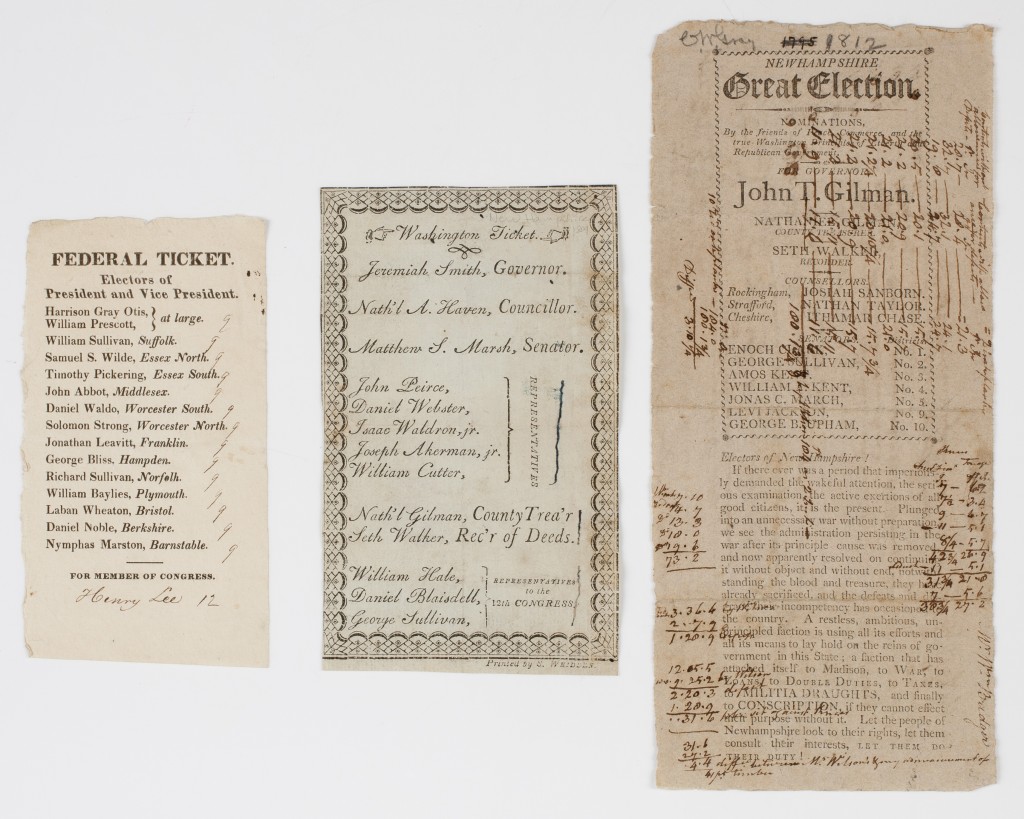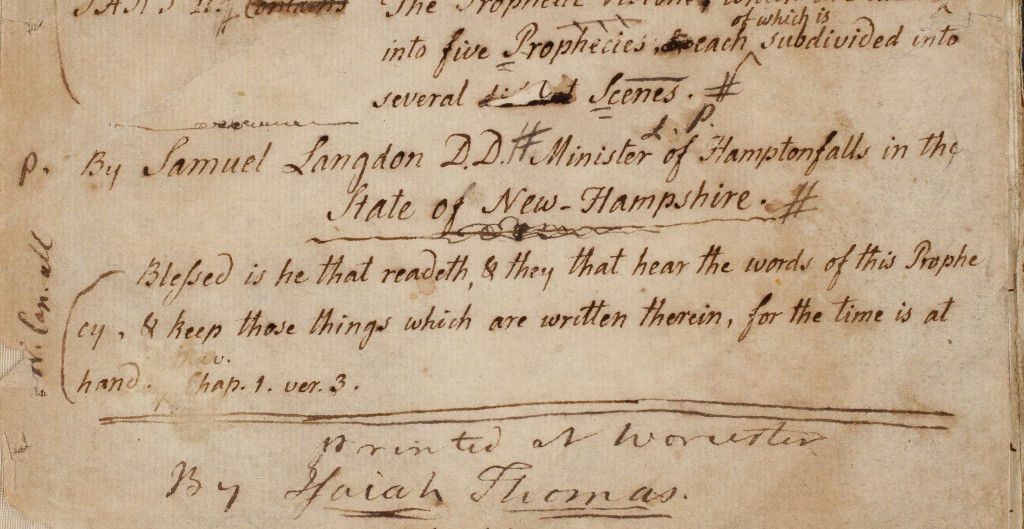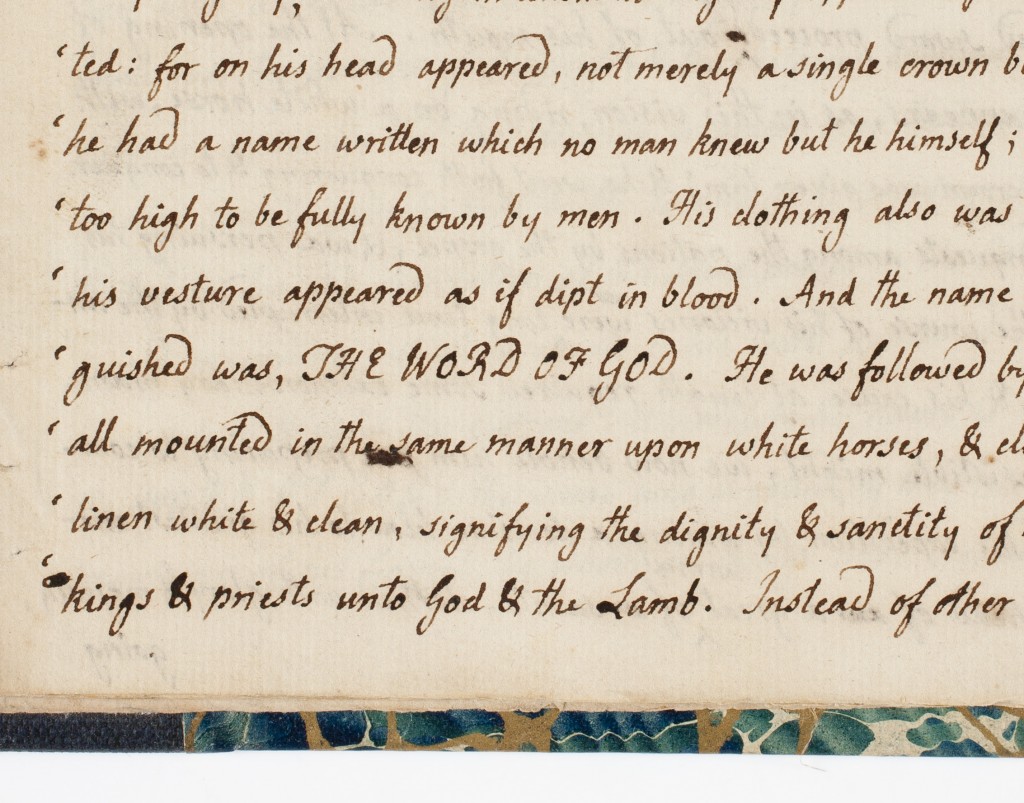Dan Boudreau is a summer page at AAS and a rising senior at Worcester Polytechnic Institute (WPI), located directly across the street from AAS. A few months ago we had posted about the work of two WPI students with the “A New Nation Votes” project. In this current post, Dan, one of those two students, shares how his experiences at AAS through that project, the American Studies Seminar, and working as a summer page have influenced his studies.
 With the end of summer and the start of a new school year fast approaching, it feels like an ideal moment to reflect on the time I’ve spent with AAS over the past several months. This coming fall, AAS will host yet another of its American Studies Seminars for Worcester’s undergraduates; back in September, the 2012 seminar served as my introduction to the world of the Antiquarian Society. Led by Stephen Marini, the seminar focused on the role of religion in the founding of our nation, and each participant was encouraged to find a specific area of interest within this broad topic. After becoming acquainted with the immensely useful resources of AAS, we each set out to conduct our own research and craft an essay on our chosen subject matter. Although I was unaware of it at the time, the start of the seminar would mark the beginning of a productive year spent with the Society.
With the end of summer and the start of a new school year fast approaching, it feels like an ideal moment to reflect on the time I’ve spent with AAS over the past several months. This coming fall, AAS will host yet another of its American Studies Seminars for Worcester’s undergraduates; back in September, the 2012 seminar served as my introduction to the world of the Antiquarian Society. Led by Stephen Marini, the seminar focused on the role of religion in the founding of our nation, and each participant was encouraged to find a specific area of interest within this broad topic. After becoming acquainted with the immensely useful resources of AAS, we each set out to conduct our own research and craft an essay on our chosen subject matter. Although I was unaware of it at the time, the start of the seminar would mark the beginning of a productive year spent with the Society.
As I was finding my feet within the American Studies Seminar, I was also embarking on another (even lengthier) academic journey. And once again, I would be working at AAS. For our junior year project, a friend and I would be helping Phil Lampi and Erik Beck transition their “A New Nation Votes” database (NNV) into the online realm. We would take the NNV project’s early American voting records and digitally map the data through a GIS—a geographic information system. Starting from scratch, we would eventually produce several dozen maps of Massachusetts displaying election returns for U.S. House races in 1798 and 1800. With the NNV project and the seminar both on my plate (along with my regular classes), I was feeling a little overwhelmed early last fall—but excited just the same.


Hoping to enhance my learning experience and ease my workload, I decided to select a seminar topic that would relate closely to the work I was doing for “A New Nation Votes.” Because the NNV project also involved historical analysis of the maps we would produce, I wanted to better understand relationships between religious affiliation and political association in turn-of-the-nineteenth-century Massachusetts and New England. If I could establish concrete connections between religion and voting preferences, I would likely be able to explain prominent electoral trends on the NNV maps.
After reading a fiery 1788 political sermon by Congregationalist preacher and Harvard president Samuel Langdon, I decided to look further into the biography of the author and began to make these connections. Luckily, I found that Langdon’s life and works illustrate many of the key links between New England’s Federalists and its conservative Calvinists. In my seminar essay, I explain as follows:

At the heart of every one of his political sermons and writings was a rigorous Calvinist, Congregationalist ethic; Langdon’s theological beliefs served as the foundation upon which his patriot and Federalist politics were built. He used classic Calvinist notions of providence, predestination, human depravity, and societal unity in order to develop political viewpoints that stressed the importance of public virtue. […] Langdon during the latter part of his ministerial career represents the typical orthodox Calvinist preacher of 1790s New England, while the ideas expressed throughout his entire body of works illustrate the essential ideological links between Federalism and Congregationalism—the links that allowed the two doctrines to flourish together during the era.

Through the example of Langdon, I was able to account for large amounts of Federalist votes in areas that were dominated by orthodox and conservative Calvinist Congregationalists. On the digital maps we had produced for the NNV project, a wide swath of Federalist votes in the Connecticut River Valley region of Massachusetts had been perplexing me (see right). I had known that its explanation would have something to do with the area’s Calvinist faith, but the exact nature of the Federalist-Congregationalist alliance still eluded me. After writing the essay on Langdon, however, I finally grasped the significance of the many links between the two doctrines and I could therefore better assess the electoral impact of the Federalist-Congregationalist establishment. I learned that Calvinist Congregationalism’s ideological compatibility with Federalism—Massachusetts Federalism in particular—allowed politically-minded ministers to easily push their congregations toward the party of Alexander Hamilton. In New England’s more secluded communities especially, conservative Calvinist voters of the lower classes were by and large Federalists. (Baptists and other Calvinist dissenters were the major exception to this rule, but that’s a topic for another day.) Thus, the rural towns of the Connecticut River Valley voted Federalist at the turn of the nineteenth century. In my NNV report, I put it as follows:
[T]he Federalists established dedicated rank-and-file support in the isolated rural communities of the Connecticut River Valley. In this part of the state, conservative Congregationalists—who tended to support Federalism—dominated the religious landscape. Conservative Congregationalists had a natural affinity for the party’s cause: in line with their traditional Calvinist ethos, the Federalist philosophy emphasized unity and stability.
And so, happily, my seminar work had tied in perfectly with my work on “A New Nation Votes.” I eventually completed both of my AAS projects successfully, and I began to look towards the summer and my senior year.
As I thought about my not-so-distant academic future early this spring, I realized that continuing my work at AAS was a must, as the further experience would undoubtedly yield even more rewards. For that reason, I quickly made plans to continue my digital mapping work on the NNV project. Not long afterwards, I learned about a summer job opportunity at AAS; I jumped on it, and thankfully got the position. For a couple of months now I’ve been paging books from the stacks, helping readers at the front desk, and working on all sorts of cool little projects. Because of this job, I’m able to bridge my junior year AAS experience with the work I have planned for my senior year. Moreover, the knowledge I’ve gained of the Society’s resources and facilities will surely help me out as I conduct my research next year.
Looking back now, it’s great to see all the ways in which my experiences with AAS have come together to benefit my academic career. The Antiquarian Society has made my last two years as an undergraduate far more interesting, challenging, and rewarding. I’m certainly glad that my school happens to be right across the street.
